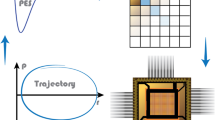Abstract
Technical details are given on how to use Fourier acceleration with iterative processes such as relaxation and conjugate gradient methods. These methods are often used to solve large linear systems of equations, but become hopelessly slow very rapidly as the size of the set of equations to be solved increases. Fourier acceleration is a method designed to alleviate these problems and result in a very fast algorithm. The method is explained for the Jacobi relaxation and conjugate gradient methods and is applied to two models: the random resistor network and the random central-force network. In the first model, acceleration works very well; in the second, little is gained. We discuss reasons for this. We also include a discussion of stopping criteria.
Similar content being viewed by others
References
G. Forsythe and C. B. Moler,Computer Solutions of Linear Algebraic Systems (Prentice-Hall, Englewood Cliffs, New Jersey, 1967); J. A. George,SIAM J. Numerical Analysis 10:345 (1973); A. J. Hoffman, N. S. Martin, and D. J. Rose,SIAM J. Numerical Analysis 10:364 (1973).
G. H. Golub and C. F. van Loan,Matrix Computations (North Oxford, London, 1986).
R. S. Varga,Matrix Iterative Analysis (Prentice-Hall, Englewood Cliffs, New Jersey, 1962).
D. M. Young,Iterative Solutions of Large Linear Systems (Academic Press, New York, 1971).
L. A. Hagelman and D. M. Young,Applied Iterative Methods (Academic Press, New York, 1981).
J. Stoer and R. Bulirsch,Introduction to Numerical Analysis (Springer-Verlag, New York, 1980), p. 572.
G. G. Batrouni, A. Hansen, and M. Nelkin,Phys. Rev. Lett. 57:1336 (1986).
G. Parisi, inProgress in Gauge Field Theory, G. 't Hooftet al. eds. (Plenum Press, New York, 1984); G. G. Batrouni, G. R. Katz, A. S. Kronfeld, G. P. Lepage, B. Svetitsky, and K. Wilson,Phys. Rev. D 32:2736 (1985).
H. E. Stanley and N. Ostrowsky, eds.,On Growth and Form (Martinus Nijhoff, Boston, 1986).
S. Kirkpatrick, inIll-Condensed Matter, R. Balian, R. Maynard, and G. Toulouse, eds. (North-Holland, Amsterdam, 1979).
R. Rammal, C. Tannous, P. Breton, and A.-M. S. Tremblay,Phys. Rev. Lett. 54:1718 (1985); L. de Arcangelis, S. Redner, and A. Coniglio,Phys. Rev. B 31:4725 (1985).
S. Feng and P. N. Sen,Phys. Rev. Lett. 52:216 (1984); A. R. Day, R. R. Tremblay, and A.-M. S. Tremblay,Phys. Rev. Lett. 56:2501 (1986).
A. Hansen and S. Roux, preprint.
W. H. Press, B. P. Flannery, S. A. Teukolsky, and W. T. Vetterling,Numerical Recipes (Cambridge University Press, Cambridge, 1986).
H. J. Herrmann, D. C. Hong, and H. E. Stanley,J. Phys. A 17:L261 (1984).
S. Roux and A. Hansen,J. Phys. A 20:L1281 (1987).
A. Aho, J. Hopcroft, and R. Ullman,The Design and Analysis of Computer Algorithms (Addison-Wesley, Reading, Massachusetts, 1974).
J. Hopcroft and R. E. Tarjan,Commun. ACM (Algorithm 447)16:372 (1973).
D. Stauffer,Introduction to Percolation Theory (Francis and Taylor, London, 1985).
H. J. Herrmann and H. E. Stanley,Phys. Rev. Lett. 53:1121 (1984).
R. Rammal and G. Toulouse,J. Phys. Lett. (Paris)44:L13 (1983).
S. Havlin, D. Movshovitz, B. Trus, and G. H. Weiss,J. Phys. A 18:L719 (1985).
S. Roux and A. Hansen,J. Phys. (Paris) 49:897 (1988).
H. E. Stanley and A. Coniglio,Phys. Rev. B 29:522 (1984).
B. O'Shaughnessy and I. Procaccia,Phys. Rev. Lett. 54:455 (1985).
W. H. Press, B. P. Flannery, S. A. Teukolsky, and W. T. Vetterling,Numerical Recipes (Cambridge University Press, Cambridge, 1986), Chapter 12.
M. R. Hestenes and E. Stiefel,Nat. Bur. Stand. J. Res. 49:409 (1952).
P. Concus, G. H. Golub, and D. P. O'Leary, inSparse Matrix Computations, J. R. Bunch and D. J. Rose, eds. (Academic Press, New York, 1976).
G. R. Katz, Ph.D. thesis, Cornell University, Ithaca, New York (1986).
A. Hansen, Ph.D. thesis, Cornell University, Ithaca, New York (1986).
Author information
Authors and Affiliations
Rights and permissions
About this article
Cite this article
George Batrouni, G., Hansen, A. Fourier acceleration of iterative processes in disordered systems. J Stat Phys 52, 747–773 (1988). https://doi.org/10.1007/BF01019728
Received:
Revised:
Issue Date:
DOI: https://doi.org/10.1007/BF01019728




